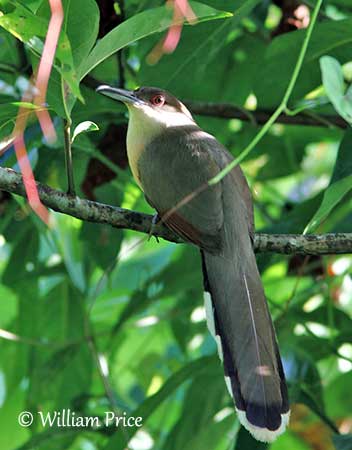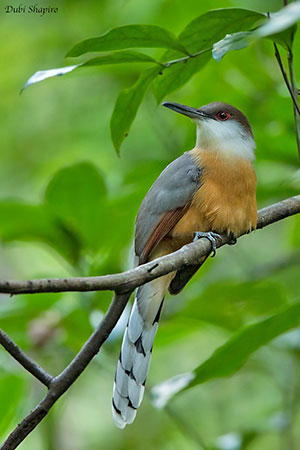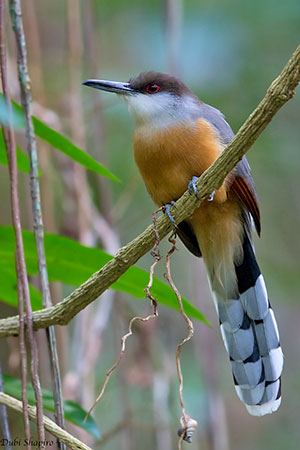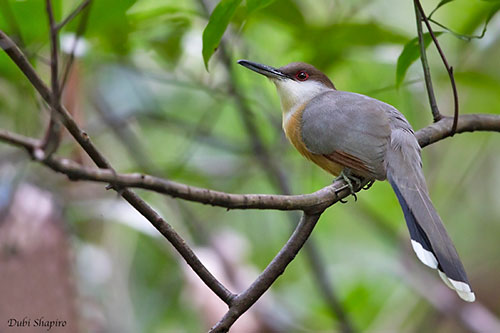
Fr: Tacco de la Jamaïque
Ang: Jamaican Lizard-Cuckoo
All: Jamaikakuckuck
Esp: Cuco lagartero jamaicano
Ita: Cuculo lacertiero della Giamaica
Nd: Jamaicaanse Hagediskoekoek
Sd: jamaicaödlegök
Photographers:
William Price
PBase-tereksandpiper & Flickr William Price
Dubi Shapiro
Dubi Shapiro Photo Galleries & Dubi Shapiro's Pictures on IBC
Text by Nicole Bouglouan
Sources:
HANDBOOK OF THE BIRDS OF THE WORLD vol 4 by Josep del Hoyo-Andrew Elliott-Jordi Sargatal - Lynx Edicions - ISBN: 8487334229
BIRDS OF THE WEST INDIES – by Herbert Raffaele, Kristin Williams et Tracy Pedersen – Helm – ISBN: 9780713649055
Cuckoos of the World Par Johannes Erritzøe, Clive F. Mann, Frederik Brammer, Richard A. Fuller – Editeurs A&C Black, 2012 – ISBN: 1408142678, 9781408142677
A Field Guide to the Birds of the West Indies by James Bond – Editeur: Houghton Mifflin Harcourt, 1999 – ISBN: 0618002103, 9780618002108 – 256 pages
Birds of the West Indies de G. Michael Flieg – Editeur: Bloomsbury Publishing, 2017 – ISBN: 1472938127, 9781472938121 – 144 pages
Neotropical Birds – Cornell Lab of Ornithology
Jamaican Lizard-Cuckoo
Coccyzus vetula
Cuculiformes Order – Cuculidae Family
INTRODUCTION:
The Jamaican Lizard-Cuckoo is endemic to Jamaica where it usually occurs through the tree canopy at forest edges and secondary growths.
It feeds on a variety of insects and lizards found in mid storey and canopy. This species is not parasitic and builds its own nest, a flat platform well hidden in tree.
The Jamaican Lizard-Cuckoo is widespread within its restricted range, but it is uncommon and more often heard than seen. The population is stable and the species is not globally threatened.
DESCRIPTION OF THE BIRD:
Biometrics:
Length: 38-40 cm
Weight: 86-105 g
The Jamaican Lizard-Cuckoo is fairly large with long, graduated tail and long, almost straight bill. However, it is the smallest of lizard-cuckoos.
The adult has greyish upperparts. On the upperwings, the primaries form a rufous patch visible on closed wings. The long tail has grey central rectrices with black subterminal band and broad white tips. The lateral rectrices are black and also with broad white tips.
On the underparts, chin and throat are whitish, whereas breast, belly and undertail-coverts are rufous, the latter being paler. The undertail appears black with broad tips to feathers.

On the head, forehead, crown and nape are dark brown.
The long, straight bill is black above but the lower mandible is paler. The eyes are brown, surrounded by red orbital skin. Legs and feet are grey.
Male and female are similar.
The juvenile resembles adult, but it has narrower rectrices and the secondaries have buff tips.
RANGE:
The Jamaican Lizard-Cuckoo is found only in Jamaica, but it is less common than the Chestnut-bellied Cuckoo.
HABITAT:
The Jamaican Lizard-Cuckoo frequents a variety of wooded habitats including wet mid-elevation forests, wooded ravines, lowland evergreen forests, wooded areas and semi-arid country with trees and shrubs. It is less common above 1,200 metres of elevation.

CALLS AND SONGS: SOUNDS BY XENO-CANTO
The Jamaican Lizard-Cuckoo gives a rapid “cak-cak-cak-ka-ka-ka-k-k” becoming faster and lower towards the end. We can also hear a braying “gaah”. This species is usually less vocal than the Chestnut-bellied Cuckoo.
BEHAVIOUR IN THE WILD:
The Jamaican Lizard-Cuckoo feeds on a wide variety of animal food such as insects (caterpillars, locusts, mantids and cicadas), spiders, lizards (Anolis), tree frogs, mice and nestling birds.
It forages by moving slowly through lower canopy and understorey. It jumps from twig to twig, climbs up in young trees, then stops to perch and twists the neck to peer about, prior to leap from tree to tree.
It may sometimes feed on the ground, and it is also observed probing into nesting cavities, holes and crevices while searching for prey.

The Jamaican Lizard-Cuckoo is monogamous and usually seen in pairs. During the displays, the long tail of the male is enhanced while it spreads both tail and wings towards the female. Copulation is typically accompanied by courtship feeding from male to female.
The Jamaican Lizard-Cuckoo is resident in Jamaica.
It mainly performs gliding flights among trees, although these species are able to fly fast with steady wingbeats.
REPRODUCTION OF THIS SPECIES:
The breeding season occurs from March to August.
The Jamaican Lizard-Cuckoo builds a platform, a flat structure made with twigs and lined with leaves, placed in a tree, in a tangle of branches and bromeliads.
The female lays 3-4 dull white to pale blue eggs. Both adults share the incubation and feed the young, mainly on lizards.
PROTECTION / THREATS / STATUS:
The Jamaican Lizard-Cuckoo has restricted range in which it is widespread but uncommon.
The population is suspected to be stable and the species is not globally threatened.
The Jamaican Lizard-Cuckoo is currently evaluated as Least Concern.
